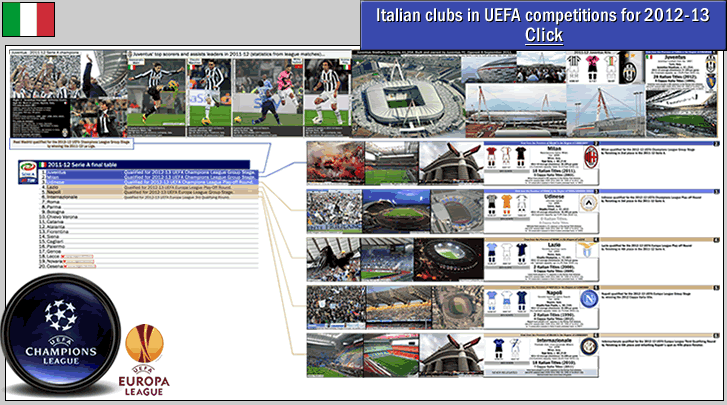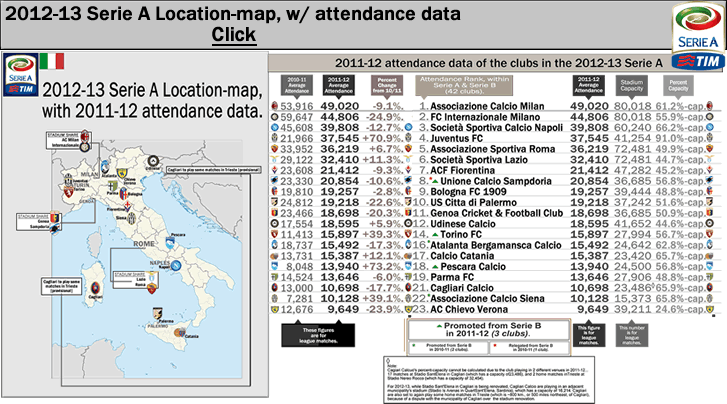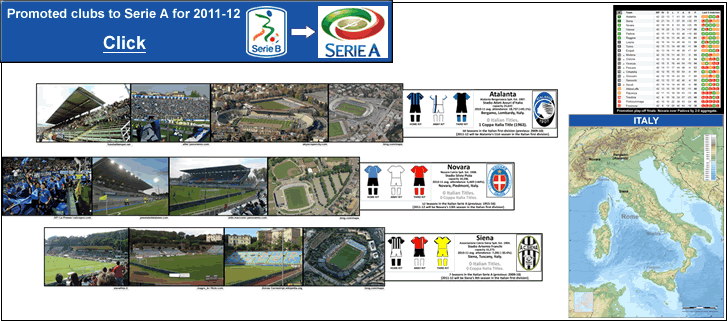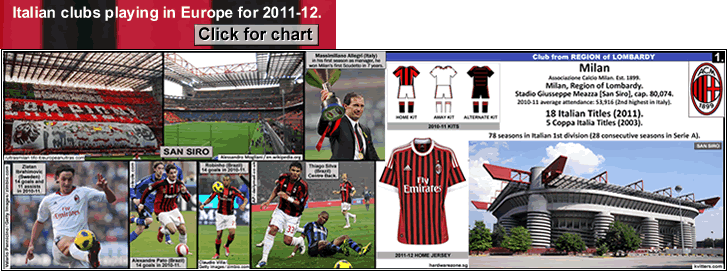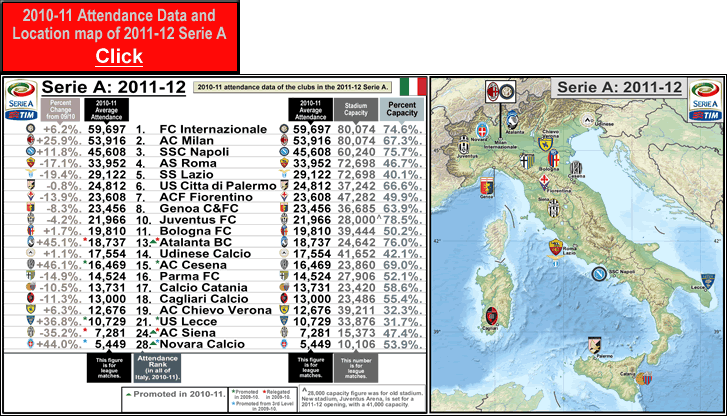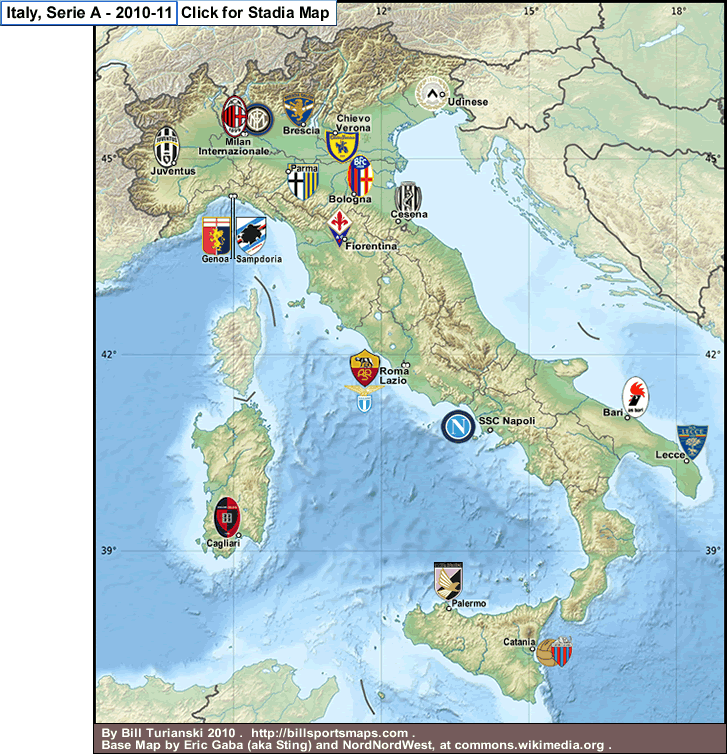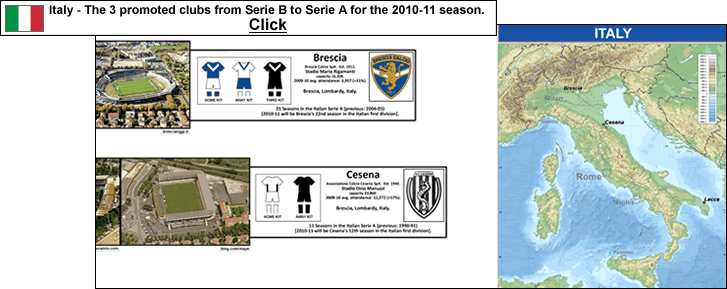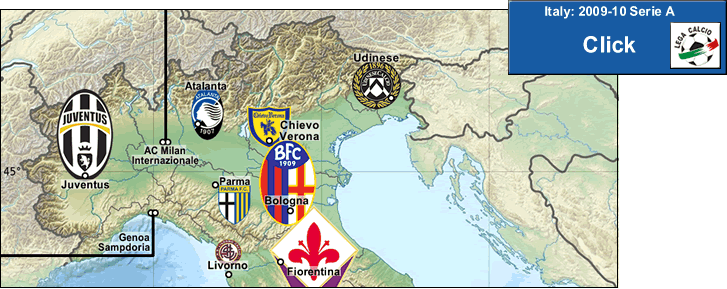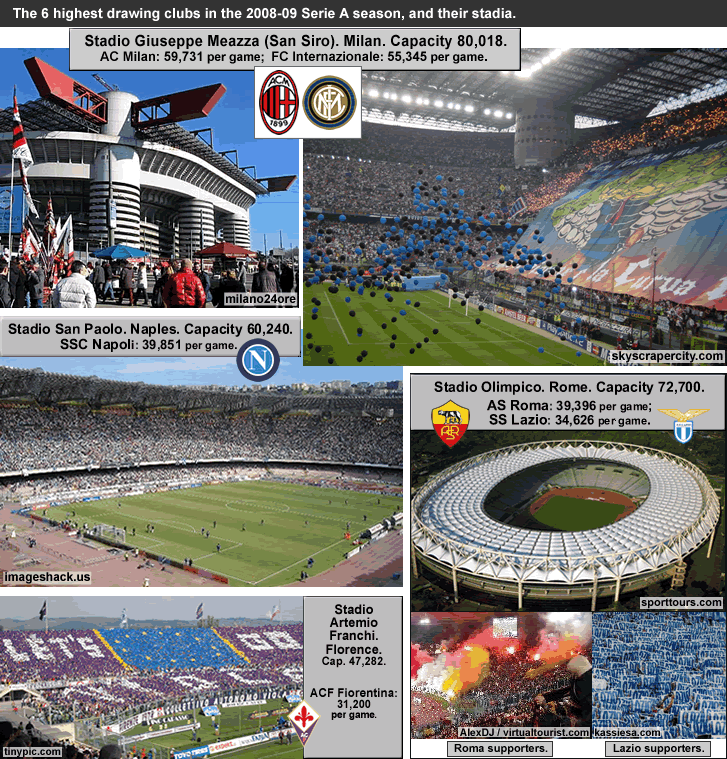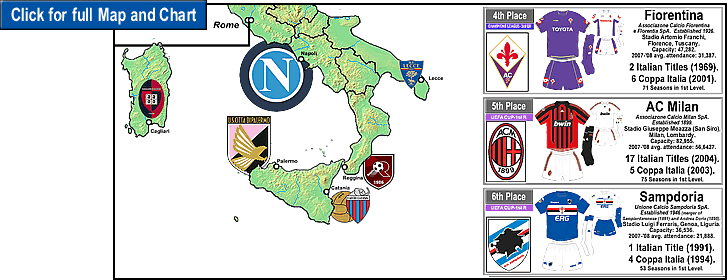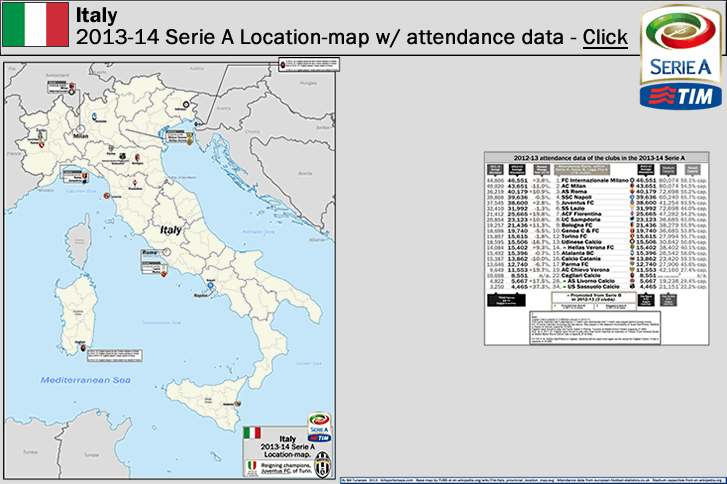
Italy: 2013-14 Serie A Location-map, with 2012-13 attendance data
…
…
(Note: to see my latest map-and-post on Italian football, click on the following, category: Italy.)
…
There was a 3.4% increase in overall Serie A attendance in 2012-13, but before you start thinking this is a sign of a revival of the Italian game, the fact is that the 3.4% attendance increase (from 23,234 per game in 12/13, versus 22,466 per game in 11/12) can be explained by 2 factors. Factor 1: 10% to 19% crowd increases at Roma, Bologna and Chievo Verona – the 3 clubs’ crowd increases, added together, put 8,043 per game extra toward the overall Serie A average attendance last season. Factor 2: the return of a couple of large-ish clubs back from Serie B last season – Sampdoria and Torino – and the relegation of three small-ish clubs following the 11/12 season – Cesena, Novara and Lecce. Here’s how I back up that assertion…Samp.+Torino avg. crowds =19,144 per game in 12/13, versus Cesena+Novara+Lecce avg. crowds=12,442 per game in 12/13, meaning a 53% increase to the overall 2012-13 Serie A average attendance via the departure of the 3 relegated clubs from 11/12 and the inclusion of the two promoted clubs for 12/13.
Nevertheless, despite not really having great, standout seasons last year, Roma, Bologna and Chievo Verona had modest-to-pretty-good crowd increases. So maybe we can see the light-at-the-end-of-the tunnel for Serie A and its near-decade-long slump. Maybe that can be seen in the 3,960 per game extra who attended AS Roma matches, and in the 2,179 per game extra who attended Bologna FC matches, and in the 1,904 per game extra who attended the home matches of the Flying Donkeys of Chievo Verona last season.
Stadia News in Italy
In one way, Italian football really has turned a corner – in beginning to produce well-designed new venues with all the expected modern amenities and with proper, steep-pitched stands and no atmosphere-destroying running track. Juventus FC led the way, with their club-owned Juventus Stadium, which opened in August 2011 (see illustration below). Juventus are the only club in Serie A to own their own stadium. Which, when you compare to the situations in most every other highly-ranked Western European league, is odd, because in England (and in Scotland), in Germany, in the Netherlands, in Spain, and in Portugal, most of the big clubs and many of the mid-sized or small clubs own their own stadiums.
Although this is not the case in France, there are many nice municipal stadiums in Ligue Un and Ligue Deux…the venues of Lille, Saint-Étienne, Lens, Rennes, and Bastia – to name a few – are all nice municipal stadiums with some good stands and no running tracks. Many if not most French municipalities who have built venues to house their first division football clubs had long ago dispensed with the misbegotten notion that it made any sense to put a little-used and superfluous running track into a facility that would be primarily used for football matches. With the exception of Milan and Genoa, Italian municipalities never got this memo. Italy may be one of the world leaders in design, but in public planning, not so much. This needs to change if Serie A ever hopes to reclaim its place as the most well-attended association football league in the world. Best-drawing league in the world was a distinction the Italian top flight held for over two decades during the mid-1970s (overtaking England’s First Division in 1972-73 [at 32,176 per game]), all through the 1980s and into the early 1990s, peaking at 38,872 per game in 1984-85, and still drawing best overall for another 9 years until Germany’s Bundesliga overtook Serie A as the top-drawing league in 1994-95 {figures here, european-football-statistics.co.uk/attn.htm}.
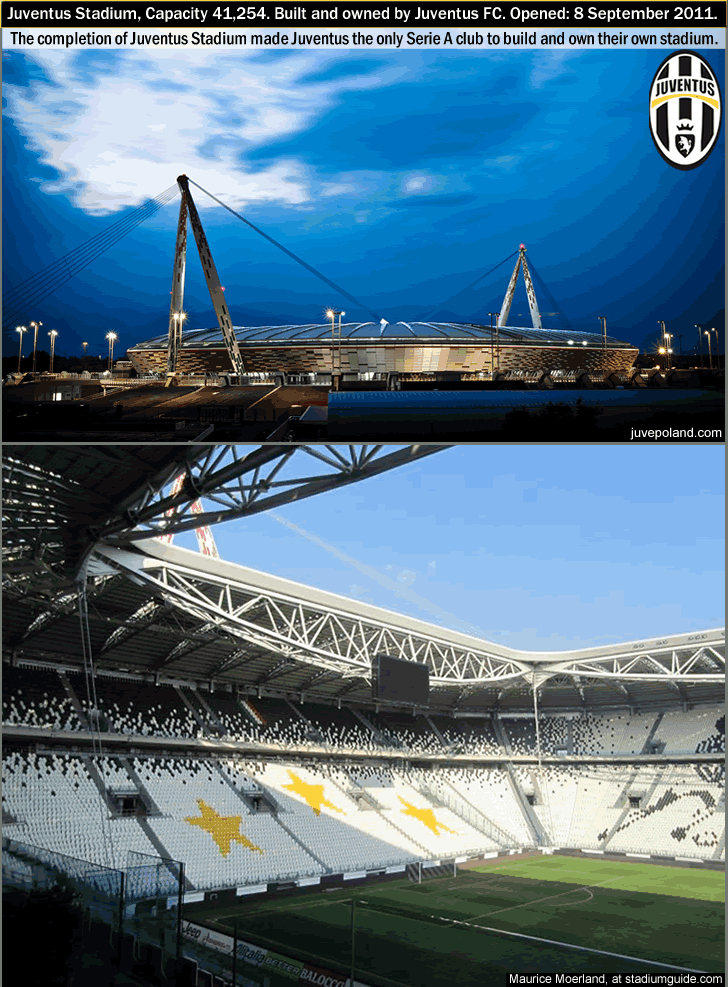
Photo and Image credits above -
juvepoland.com.
Interior photo of Juventus Stadium by Maurice Moerland, at stadiumguide.com/juventusstadium.
In Genoa, there is a very nice municipal stadium, Stadio Luigi Ferraris {‘Stadio Luigi Ferraris‘ (stadiumguide.com)}, which, unlike almost all large top-flight municipal stadiums in Italy (besides San Siro in Milan), has never had a running track. Sampdoria share it with local rivals Genoa C&FC. Despite the excellent venue, and perhaps in part because they wish to literally distance themselves from their rival, Sampdoria have long wished to build and own their own stadium. Now they have preliminary plans in place – see the following. From Stadium Guide.com, from 14 April 2013, ‘Sampdoria take step closer to seafront stadium‘.
Meanwhile. Udinese, a club that has been trailblazing in a different way (with satellite-clubs in England and Spain/ see caption in illustration below), have taken the cue from Juventus. Working with the owners of their home-stadium, the city of Udine, Udinese have totally re-designed and renovated the Stadio Friuli. To say the people involved in Udinese’s stadium re-design were influenced by the design of Juventus Stadium would be an understatement. Here is an article on that from TheScore.com, ‘Udinese Hope To Provide a model For Serie A in Stadio Fruli Revolution‘ (by Paolo Bandini on 8 April 2013 at thescore.com/counterattack-blog).
More stadium news in Serie A for 2013-14 can be found at the next link. From the excellent site ForzaItalianoFootball.com, ‘Serie A Summer Stadium Changes’ (by Marco Jackson on 6 July 2013 at forzaitalianfootball.com).
Below: Udinese Calcio (owned by the Pozzo family), and Stadio Friuli (owned by the municipality of Udine, Friuli, Italy).

Photo and Image credits above -
13/14 Udinese kits from ‘Udinese Calcio‘ (en.wikipedia.org).
Photo of former configuration of Stadio Friuli unattributed from udin-e.it.
Udinese crest/flags from banner at udinese.it.
Image of Stadio Friuli redevelpment plan uploaded by Franz85 at skyscrapercity.com.
…
12/13: The Twilight Zone season of Cagliari Calcio – 3 home venues (one of which was 800 km. away), 2 matches played behind closed doors, one match abandoned and lost, one president under house arrest, an improvised dual-manager partnership – and a strong 11th place finish for the Isolani of Sardinia
Speaking of attendance problems (and of ongoing dysfunction in the calcio world), Sardinia-based Cagliari Calcio ended up playing (so far) 2 more matches in Trieste – where Cagliari have now played some of their ‘home’ matches for the third consecutive season – and they will play another on Sunday 29 September 2013 (v. Inter). Cagliari will have ended up playing [so far] 11 ‘home’ matches there. From ForzaItalianFootball.com, from 25 Sept. 2013, by Marco Jackson, ‘Cagliari Stadium Return Delayed Again‘ (forzaitalianfootball.com).
This does not sound so bad if you are not familiar with the geography of Italy. But Trieste, in the region of Friuli-Venezia Giulia, is the furthest north-eastern location in Italy, and is basically not on the Italian peninsula but on the Balkan peninsula, and is a whopping 810 km. or 530 mlles NE of Cagliari (as the crow flies). But that doesn’t even begin to describe how difficult for Caglliari fans it was to get from Cagliari to Trieste, because if you don’t take a plane flight there, and if you tried to drive there, you would first have to take a ferry from Sardinia to the Italian mainland, then drive north up the spine of Italy, then make your way east all the way to the Italian/Slovenian border. There, on a narrow strip of Italian territory lying between the Adriatic Sea and Slovenia, is the 205,000 population city of Trieste. [Trieste is just 72 km. or 45 miles SW of the Slovenian capital of Lubljana.]. To travel by car-ferry-car from Caglari to Trieste would end up being an expensive, arduous, and headache-inducing journey of about 1,061 km. or 659 miles. One note – the venue there in Trieste, the Stadio Nereo Rocco, is actually quite nice (as you can see in the satellite image below). It is just a shame that a club and its supporters, clear across the other side of Italy, were forced to call it home for a while.

Image credit above – aerial satellite image from bing.com/maps/Bird’s Eye view.
The reason for all this was because the venue (the 23,00-capacity Stadio Sant’Elia) that Cagliari Calcio had called home from 1970-71 to 2011-12 was in such state of disrepair. But the municipal authorities in Cagliari refused to work with the club to improve the venue. So just prior to the 2012-13 season the club president, Massimo Cellino, tried to build a quasi-new stadium in the adjacent municipality of Quartu Sant’Elena – the Is Arenas (capacity 16,500). That venue in the eastern suburbs of Cagliari was once the stadium of a 3rd division club, but had not been in use since the mid-1980s. It ended up having a re-build, but it was a slapped-together rush-job. 3 new stands were hastily installed in the summer of 2012 – stands made of steel and pre-fab materials held up by a maze of what was essentially scaffolding and that looked anything but safe (see 3rd photo below).
The authorities on the island of Sardinia stepped in, in late August 2012, and banned spectators from attending matches there until the venue could get a proper safety clearance. Cagliari’s first home match in the 12/13 season, a 1-1 draw versus Atalanta on 2 Sept. 2012, was played behind closed doors and without spectators. Then the Cagliari front office ignored this ongoing spectator-ban and started selling tickets on the official club website for their second home match. As you might imagine, the authorities were not pleased with this development…so the club’s second home match last season, on 23 Sept. 2012, was abandoned, and the result was given to the visitors, Roma, by a 0-3 score. Cagliari finally got a safety clearance for the Is Arenas for their third home match, and the club ended up playing 12 matches with spectators there (15 total).
So then, through the fall of 2012 and early 2013, six home matches – with spectators allowed to attend – were played at the Is Arenas there in the eastern suburbs of Cagliari, including a 16,000 sell-out versus Napoli on Friday the 26th of November (Napoli won that match, 0-1). Those 6 home matches in the early part of the 12/13 season also included a 1-1 draw v. Catania where the main stand at the Is Arenas was closed, and the match drew only about 4,000.
In 2011-12, Cagliari had been in a relegation battle and finished 16th. After 6 games into 2012-13, Cagliari were dead last in the table, with 4 losses and 2 draws. Their manager Massimo Ficcadenti was sacked, and on 2 October 2013, former Cagliari player Ivo Pulga was named as new manager, alongside newly-appointed assistant Diego López, in a surprise move. Former Cagliari DF López played 12 seasons for the Isolani (from 1998 to 2010), making over 400 appearances for the team, and retiring after 2009-10. López would have been named manager, but the veteran (with 32 caps for Uruguay) did not have his UEFA coaching badges at that point in time (currently [2013-14], the two have switched roles, with the now-39-year-old López in the manager’s role for Cagliari, and with Pulga now as first team coach). Pulga, who had played as a MF for Cagliari from 1985 to 1991, had been coaching the youth set-up at Modena, and had never managed a pro squad. But he (and his assistant Diego López) brought in a good passing style of football to the Isolani squad, and they brought results. The Rossoblu finally won their first game the next match, away to Torino. And then Cagliari won their next 3 (v. Bologna, away to Sampdoria, and v. Siena). By January, Cagliari was long gone from the basement and starting to look like they could actually avoid relegation that season, in spite of it all.
Then out of the blue, the stadium issue arose again, and the authorities ruled that Cagliari had to play one of their mid-season home matches, on 12 February 2013 versus Juventus, on the Italian mainland, in Parma, in the central-Italian region of Emilia-Romagna. Wow, how convenient for convicted-match-riggers and reigning champions Juventus [see Calciopoli scandal of 2006], who suddenly didn’t have to fly out to Sardinia, and who, of course, went on to win the match 1-3. The distance from Juventus’ home-city of Turin, to Parma, is only about 244 km. or 151 miles via roadway. So this match effectively became more of a home match for Juventus than it was for Cagliari. Also in February 2013, being charged with embezzelement and false representation in the rebuilding of the stadium, the president of Cagliari Calcio, Massimo Cellino, along with the mayor of Quartu Sant’Elena, was arrested and jailed, on accusation of diverting a substantial sum, see this ‘Cagliari President Massimo Cellino ‘arrested in stadium investigation’‘ (independent.co.uk from 14 Feb.2013 by Brian Homewood). Then the authorities put Cellino under house arrest, not at the president’s home, because Cellino’s official residence is in Miami, Florida, USA, but – wait for it – in the Cagliari training facilities. And Cagliari’s training facillities are quite posh (unlike their stadiums). With this development, the Cagliari stadium controversy was starting to sound like the plot-line to a sitcom.
But back to the Cagliari v. Juventus match in Parma – why were Cagliari suddenly forced to play Juventus on the mainland, close to Turin? One cannot help but be suspicious of this, and see Juventus’ hand in this abrupt, unexplained, and convenient-for-them change in venue for this match. After Juve were so nicely accommodated with their extra de-facto home game, Cagliari then were allowed to play 5 consecutive home matches at the Is Arenas through the late winter and early spring of 2013. But then for the 30 March 2013 match of Cagliari v. Fiorentina, authorities re-instated the ban on spectators at the Is Arenas [I could not find any explanation for this re-instatement of the ban on spectators there, other than explanations like this one...'fans were barred because of ongoing safety concerns' (theflorentine.net from 11 April 2013 by Sam Lawley)].
Despite the empty stadium (some Cagliari fans were able to watch the match outside the ground through a narrow gap in the gates to the stadium), Cagliari beat la Viola 2-1, and so, despite their Twilight-Zone season, the Cagliari squad continued to play well and get results. The Isolani had gelled despite being faced with an almost unparalleled set of circumstances, and with the Pulga/López dual-manager arrangement, the Cagliari squad was producing result after result.
From The Guardian, from 11 March 2013, by Paolo Bandini, ‘Cagliari’s fans get a win to cheer – it’s just a pity they can’t see it A siege mentality has taken hold of a club with an uninhabitable stadium, a president under arrest and a board that has resigned‘ (theguardian.com/football).
Below, Cagliari’s stadium controversy of 2012-13.

Photo and Image credits above -
Photo of Stadio Sant’Elena in Cagliari from sardegnasport.com.
Photo of the exterior of the hastily-built Is Arenas, from corrieredellosport.it.
Photo of Cagliari fans at the short-lived Is Arenas, from foxsportsasia.com.
Photo of makeshift infrastructure of the stands at Is Arenas, from efectofutbol.net/la-crisis-estructural-del-calcio-cagliari-el-club-huerfano/stadio-is-arenas.
Photo of Victor Ibaraba by Roberto Tronci/EPA, via theguardian.com/football/blog/2013/mar/11/cagliari-sampdoria-behind-closed-doors-seriea.
Screenshot of video image of Marco Sau goal celebration from video uploaded by Love Football Italia at youtube.com, ‘Marco Sau Goal (71′) Napoli vs Cagliari (3-2) Official HD Highlight‘ (youtube.com).
Photo of Radja Nainggolan, from palembang.tribunnews.com.
Photo of Cagiari players in celebration, from thegentlemanultra.tumblr.com.
Photo of 12/13 Cagliari manager Ivo Pulga from, terzapaginaonline.it/cagliari___________________campionato_2012-013.html .
Photo of 13/14 Cagliari manager Diego López from cagliaricalcio.net via futbol.com.uy
This abilty of the Isolani squad to get results in the face of the ongoing stadium imbroglio was again evident in their next home match, when yet again the ban on spectators at the Is Arenas was lifted. This was their 15th home date, in the 32nd week of the 12/13 season, versus Internazionale. Cagliari won 2-0 over the Milanese giants. But that was the last time the authorities allowed Cagliari to play at their makeshift venue. So just like in 2011-12, Cagliari ended up playing their final home matches clear across the other side of Italy in Trieste [Cagliari had played their final 4 home matches in Trieste in 2011-12, and they played their last 3 home matches there in 12/13.]. As The Gentleman Ultra said in the article linked to below, Cagliari playing home matches in Trieste is like ‘the equivalent of Shamrock Rovers playing their home games at Watford’. Attendance was around 9K to 10K for those 3 matches. Cagliari ended their 2012-13 Serie A campaign-from-hell by beating Lazio 1-0 in Trieste, and the Isolani finished a very credible 11th place. The fate of the makeshift Is Arenas is in limbo now (it might be demolished), and Cagliari have moved back into their old venue in Cagliari, the Stadio Sant’Elia, now that a truce has been reached between the club and the city, and hasty renovations there have been completed.
I’ll leave the final word on this whole affair to the Gentleman Ultra, but before that article below, I thought I’d re-print AC Milan’s official statement on the whole Cagliari stadium controversy of 2012-13…
[Official announcement from AC Milan:] ‘The league has announced that the Cagliari-Fiorentina match will be played behind closed doors. On February 10, 2013, Milan played before a full stadium, like six other teams. Three teams played in front of only season-ticket holders, three behind closed doors. Only one, Juventus, [played] at a neutral ground. In one instance, a 0-3 was awarded (to Roma), and nobody knows what will happen in the next few days…
In light of decisions that any person of good sense would judge incomprehensible on account of the different rulings in essentially identical cases, it’s clear that the normal course of the Serie A championship has been altered.”…{end of statement from AC Milan on 29 March, 2013 (via this article by Mark Doyle, ‘AC Milan: Cagliari stadium controversy has ‘altered’ championship‘ at sports.yahoo.com)}.
From The Gentleman Ultra, ‘The Isolani’s Season in Review‘ (thegentlemanultra.tumblr.com, from 25 May 2013, by Richard Hall).
___
Thanks to the contributors at en.wikipedia.org, ‘2013–14 Serie A‘.
Thanks to the following Wikipedia contributor…base map by TUBS at en.wikipedia.org, ‘Italy provincial location map.svg‘.
Thanks to E-F-S site for attendance figures, http://www.european-football-statistics.co.uk/attn.htm.
Thanks to Soccerway.com for Serie A match details from 2012-13, http://int.soccerway.com/national/italy/serie-a/20132014/regular-season/r21388/.
Thanks to the Gentleman Ultra.







